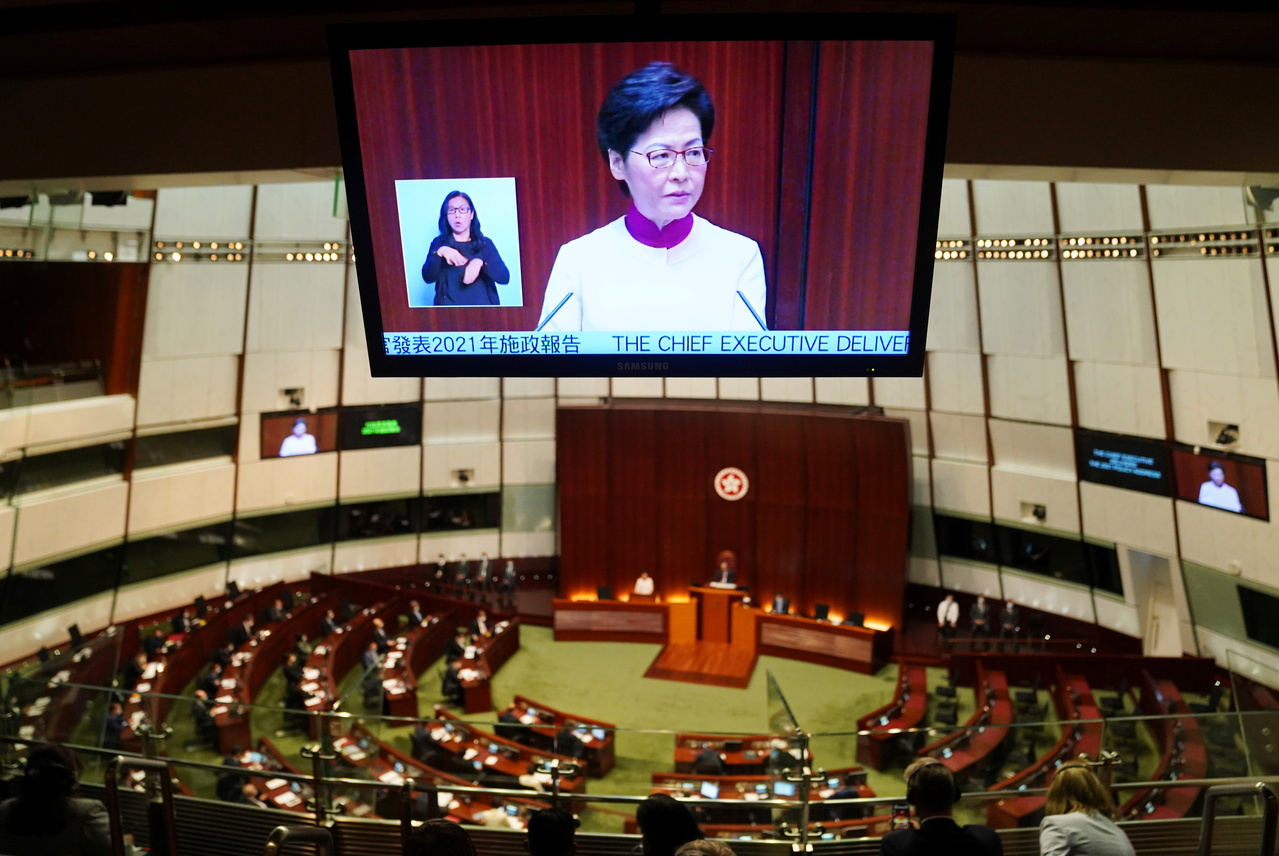Hong Kong leader Carrie Lam outlines major housing plan, defends security law in policy speech
Sign up now: Get insights on Asia's fast-moving developments

Hong Kong Chief Executive Carrie Lam delivers her last annual policy address at the Legislative Council in Hong Kong on Oct 6, 2021.
PHOTO: REUTERS
Follow topic:
HONG KONG (BLOOMBERG) - Hong Kong Chief Executive Carrie Lam on Wednesday (Oct 6) outlined plans to develop the north of the city into a metropolitan area, with as many as 926,000 homes, to ease a housing crisis that has been a major source of unrest in the financial hub.
The proposed northern metropolis will cover about 300 square kilometres of land along Hong Kong's boundary with Shenzhen, and its development will deepen ties between the cities, Lam told the Legislative Council in the final policy address of her current term. The area will be developed into an international information and technology hub, she said.
Beijing has exerted increasing control over the former British colony, pushing for its greater integration with nearby mainland cities, and has repeatedly demanded reforms to the world's least-affordable housing market.
Lam began the final policy speech of her current term with a broad defence of the national security law imposed by China, saying it had ended chaos and brought stability and better governance to the financial hub.
Lam's five-year term, which ends in June, has been marked by huge anti-government protests, widespread international criticism about the national security law, and the Covid-19 pandemic that worsened a recession and led to unprecedented border controls in the top Asian financial hub.
Hong Kong "has got back on the right track of One Country, Two Systems," and "governance has returned to normal under the protection of the national security law and the principle of patriots administering Hong Kong," Lam said in her opening remarks.
Aviation and transport
On Hong Kong's Covid-zero strategy in dealing with its coronavirus situation, Lam said that even though the city is one of the few places left in the world adhering to such an approach, she believes that it can still retain its status as an international hub.
"Although the global aviation industry, with Hong Kong being no exception, has been hard hit by the Covid-19 pandemic, I remain confident that our status as an international aviation hub could be consolidated and enhanced," she said.
The construction of a 3,800-metre-long third runway will help Hong Kong International Airport's competitiveness and the reclamation of around 650 hectares of land is largely complete. HKIA is also "proceeding at full speed with various high-end logistics projects in view of the rapid development of cross-boundary e-commerce in the region", she added.
Hong Kong is also keen to establish an aviation industrial cluster in Zhuhai in southern China that would deal with things like aircraft maintenance, parts manufacturing and research on aircraft engineering. That Chinese city, along with others in the Greater Bay Area, could also be a source of talent.
Boeing said recently that China's civil aviation industry will need more than 400,000 new personnel including pilots, cabin crew and technicians by 2040, as well as 8,700 new aircraft.
Lam also outlined greater cooperation with Zhuhai airport, saying the Airport Authority of Hong Kong will inject equity "on the basis of market principles," although no further details were given.
The chief executive also touched on tourism, which due in large part to Hong Kong's onerous quarantine measures, remains depressed. She said the city needs to "get prepared for the recovery" and that includes planning for cruise-industry development and facilitating the staging of various events.
In terms of green transport, she reiterated the government's pledge to cease the new registration of fuel-propelled and hybrid private cars in 2035 or earlier and install more electric-car charging facilities. Local authorities will also work with bus companies "to conduct trials of hydrogen-fuel-cell buses, with a view to formulating a specific roadmap and timetable for the use of new energy public transport in 2025".
Other highlights of Lam's speech
- New railway projects include a Hong Kong-Shenzhen Western Railway to reach Qianhai, extending the planned Northern Link to the new Huanggang Port in Shenzhen, and potentially expanding the East Rail Line to Luohu next to Shenzhen.
- Plans for the proposed northern metro area to have 905,000-926,000 residential units, including the existing 390,000 units in Yuen Long and North district. The residential units will accommodate a population of about 2.5 million. Lam projects the total number of jobs in the northern metropolitan area to eventually increase to about 650,000, including 150,000 IT-related jobs.
- A government restructuring proposed that will include: Splitting up the Transport and Housing bureaus; setting up a Culture, Sports and Tourism bureau; and the creation of an expanded Innovation, Technology and Industry bureau.
- Hong Kong will also consider allowing southbound trade of mainland stocks denominated in the yuan.
- Plans to use about 350 hectares of land to build about 330,000 public housing units in the next 10 years.
- Seeking to secure about 170 hectares of land in the next decade to facilitate 100,000 private residential units through land sales or railway property developments for tender.
- Plans to devote about HK$240 billion (S$41.9 billion) over the next 15 to 20 years to address climate change, with an interim target to cease using coal for daily electricity by 2035.

